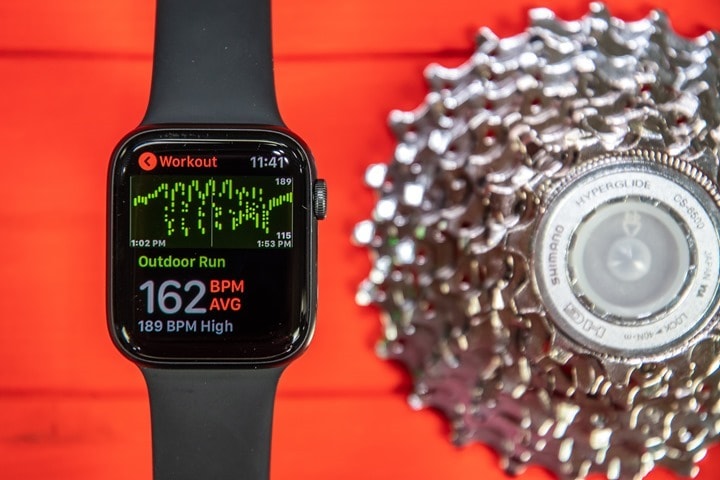
It’s been two months since the Apple Watch Series 5 came out, and the watch has been on my right wrist every one of those days. Swim, bike, run…and plenty more. You may remember my initial thoughts on it back in September after the first few days worth of workouts. Did things get better? And is it actually a better watch than Series 4 for sport and fitness? Back in September, the answer was a definite no. But with a pile of updates later, I kept on using it hoping that future firmware upgrades would resolve the issues I saw.
Now – before we get into the full review, let me just simplify what’s actually changed at the watch level from the Series 4 to the Series 5, since it’ll only take a second:
– Always-on screen added (and battery life reduced accordingly)
– New magnetic compass added
– Emergency international calling for LTE/Cellular editions
Now, in some ways that might be slightly misleading – because as part of iOS13 and WatchOS6, the Apple Watch (as a platform) got a bunch of new features. But virtually every previous Apple Watch also got those same features. Still, the stand-out ones are as follows:
– New ‘Trends’ tab on Activity app in watch
– New medical research enrollment app/functionality
– Standalone WatchOS app store (on the watch itself) – still requires an iOS device though
– Women’s menstrual cycling tracking
– Hearing health (monitoring loud noises/sounds)
– Live music streaming API’s
– Ability to add elevation as a data field for a workout
– Ability to use stop-watch mid-workout
– Better Apple Health summary information
Of course – only a handful of those actually related to sport and fitness (the title of this review). Still, some of those app bits are actually fairly notable. And they specifically fill in some serious gaps that Apple has had in competing at the end-user level against the Fitbit and Garmin apps (things like better reports/trending). But, we’ll get into all of that a bit later.
Finally, as always – I note the source of my device. Which in my case was simply me pedaling down to the Apple Store and buying it myself. I’ll continue to keep this unit for various tests over time, though, my wife also bought one which we returned after she decided it didn’t meet her fitness/sport requirements (more on that later too). So, let’s get rollin’!
Unboxing:

The Apple Watch Series 5 unboxing ‘experience’ is virtually the same as the Series 4. Which isn’t a bad thing, because that’s an awesomely designed box. It opens up like a flower in front of you, showing all the goodness that’s inside. In this case, I did the photographic unboxing of my wife’s watch, since I did my watch via video instead. No double-unboxing cheating on this post!
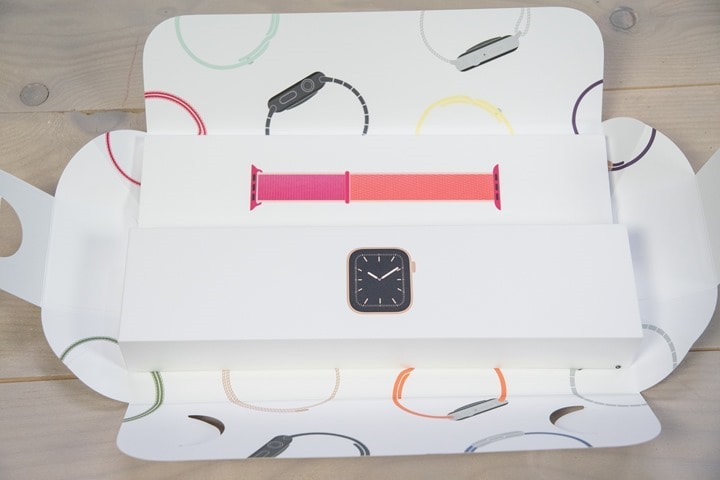
Inside you’ve got the strap on one layer, and the small watch pod on another. The pod sits next to the Apple Watch charger and wall plug. Those also remained unchanged since the original Apple Watch.
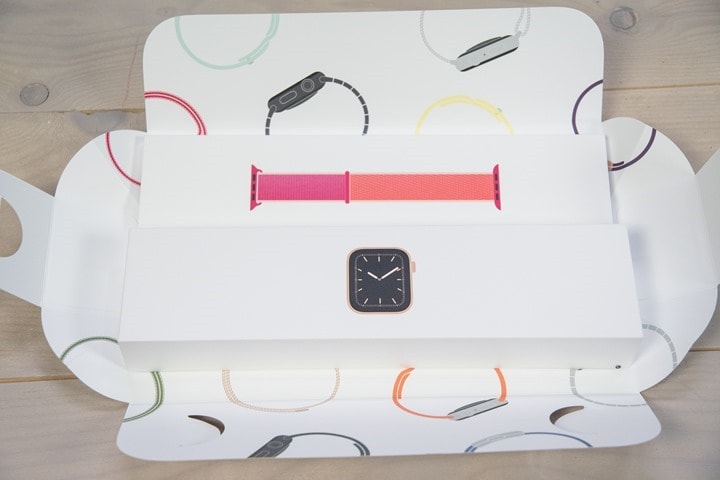
Here’s a closer look at the pod in its small fabric home:
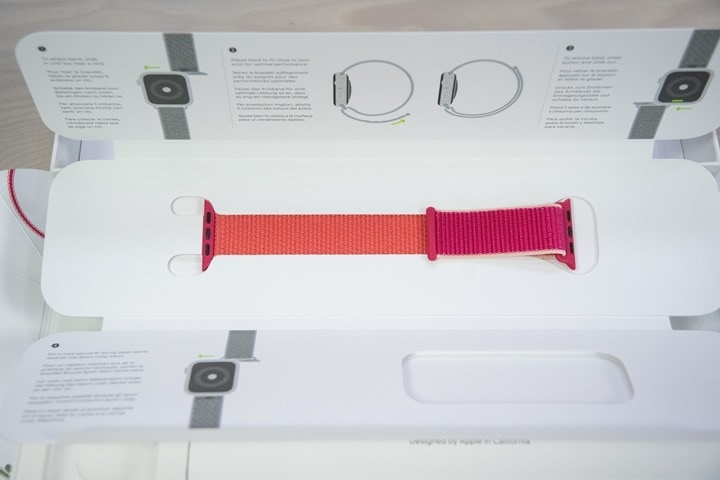
And then the standard USB wall charger plug. In my case, an EU plug because I’m in the Netherlands, but it’ll vary based on what country you’re in.

And then the charging cable:


After that, we can slide the watch out, and attach it to the straps.
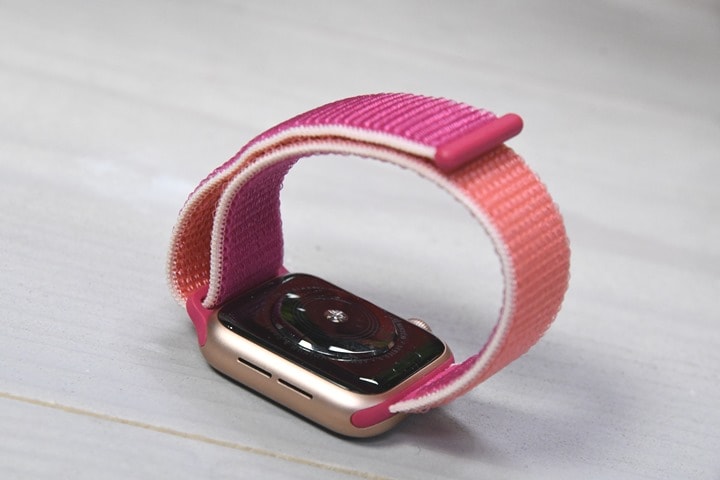
Switching to my main watch, here’s the removable straps. This allows you to buy other Apple Watch straps and simply slide them in easily.
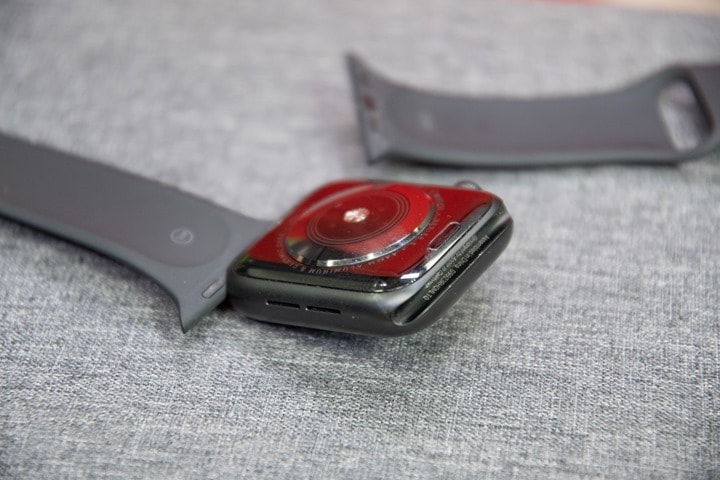
The Apple Watch comes with two different sized straps – a smaller one and a larger one, so it’ll fit most wrists. Finally, if you’re curious about the display sizes of the variants (40mm and 44mm), here’s those side by side:
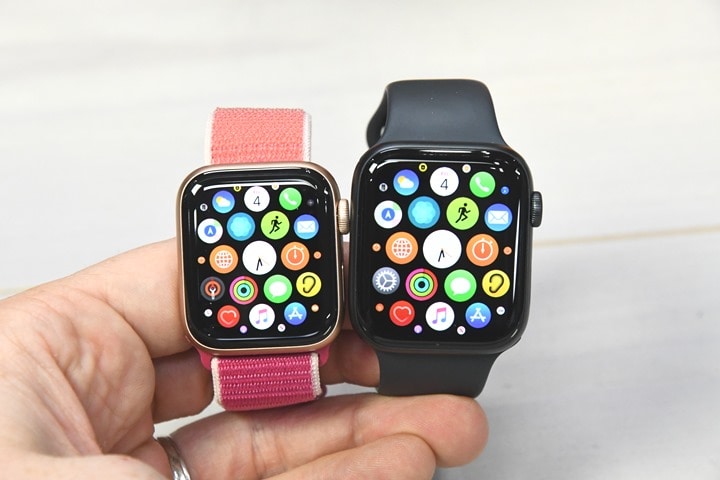
And that’s your extensive unboxing in a nutshell.
The Basics:

Let’s just dive right into the biggest and most obvious change you probably already know about: The always-on screen.
Apple joined basically everyone else this fall in offering an always-on screen. For example, Samsung’s had it for a while. Then Fitbit and Garmin both offered products with it within a few days of each other. In the grand scheme of watches, what Apple’s done isn’t really terribly different than the others. They’ve traded battery life for an always-on high-resolution display. They tweak the refresh rate on that screen depending on various circumstances to assist in battery life.
However, no matter how you slice it – Apple’s battery life timeframes are the worst of the bunch. While things were super-bad when the Series 5 first released (I couldn’t even make it to the end of the day), now I’m roughly able to get from wake-up till early into the next morning (assuming no massive GPS workouts). Still, compare that to the Garmin Venu where I get a solid 2.5-3 days with always-on, and the Fitbit Versa 2 that’s in roughly the same ballpark.
However, I’d easily point out that the Apple screen is far clearer, and also better at subtlety – primarily night-time. With a newborn ‘released’ just a few days after the Apple Watch released, I’ve spent many a night awake in the dark. Even on their dimmest setting the other watches are still beacons – whereas the Apple Watch display is incredible at night at not being a beacon.
But again – there’s trade-offs. The Apple Watch always-on display doesn’t work for any 3rd party apps (and even some Apple native apps). It just goes fuzzy, like this – you can see the time is shown, but the underlying app is fuzzed out:
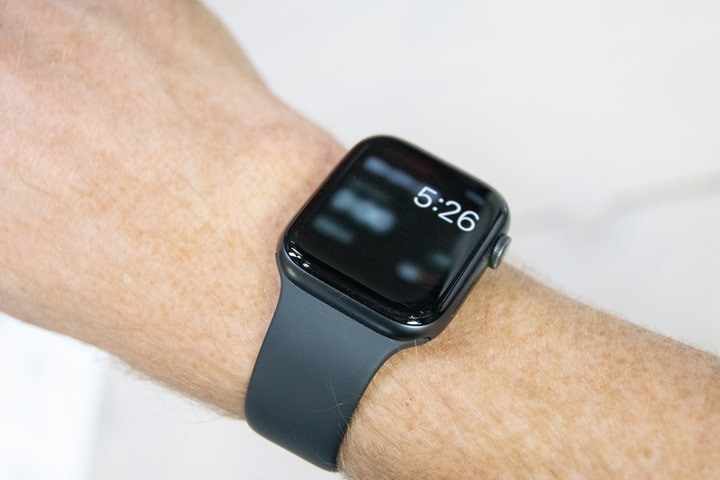
And there’s no announced plans from Apple to change that (whereas Garmin and Fitbit can use always-on all the time). The nearest timeframe we’d likely see any changes there is next summer after WWDC.
So let’s set the screen aside for now. The rest of the exterior of the Apple Watch Series 5 is virtually indistinguishable from any other past watch. There’s still just the two physical buttons. One in the lower right corner, and then the digital crown that can both rotate and be pressed in.
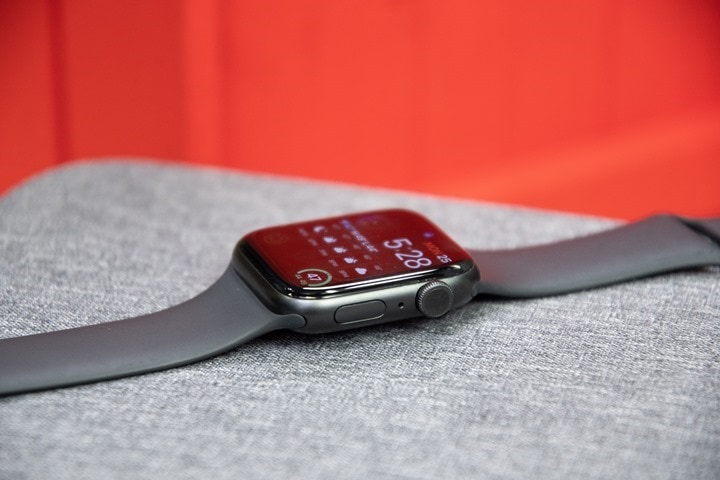
These buttons along with the touchscreen that kinda works with gloves form the entirety of your interaction experience. Except for voice commands, for which you can use Siri. Fitbit introduced Amazon Alexa in the Versa 2, though, it can’t speak back to you. So it’s kinda a bit of a mute.
When it comes to customizing your default watch face, Apple gives a pile of options. But unlike every other company, there’s no method to use 3rd party watch faces. Essentially saying: If you don’t like what’s there…get a different watch. It’s an approach I’ve always found bizarre given how strong Apple’s app ecosystem is otherwise.

Below are some of the faces in the gallery. For the most part, while there is differentiation, they kinda all have much the same feel to them (with many simply having tweaked variants). Again, there’s nothing 3rd party in here and you can’t make your own.
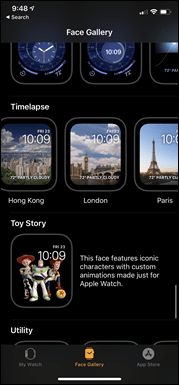
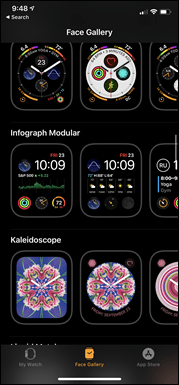
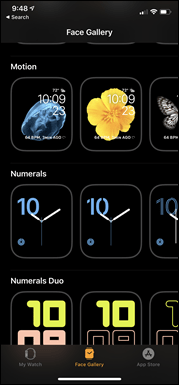
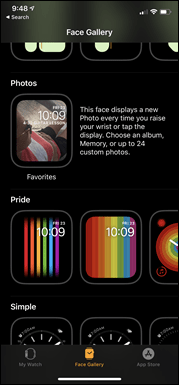
However, we see that same watch-face stubbornness on display in other areas. For example, you actually can’t add ‘Steps’ to your watch face. A bizarre omission that literally even $ 15 watches at Walmart have these days. You can technically find 3rd party complications (that’s the term for the small bits of information you can place on the watch face), but those have additional limitations on refresh rate (plus you have to buy or add the app). In fact, this was a core reason why my wife ultimately returned her Apple Watch. She wanted steps to display on it, with a daily step goal in mind during pregnancy.
For as many other complication metrics on the watch face as there are (for example UV strength), how there’s no simple step count option is mind-boggling.
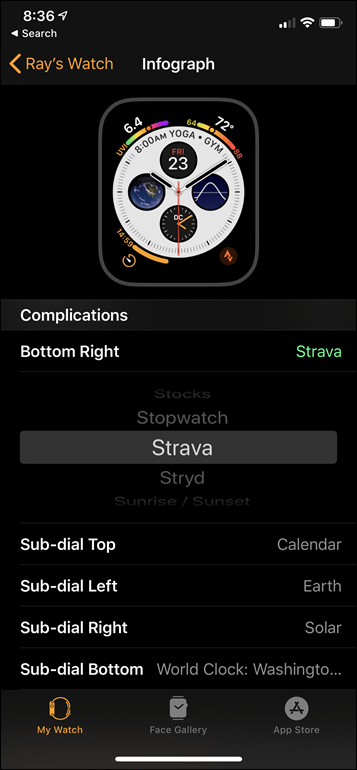
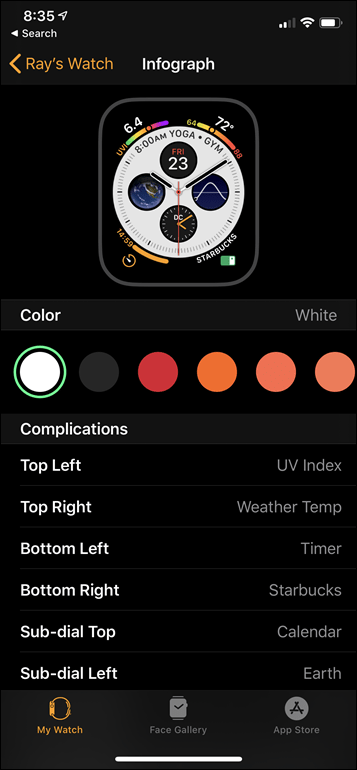
Now, this may sound like I’m nit-picking. And perhaps I am. But this is a sport and fitness review. Not a ‘is it a good all-around watch review’.
Because if it were just a general review I’d tell you (as I have since the original Apple Watch) – that Apple makes *by far* the best all-around smartwatch. The nuance of everything on the watch is super smooth, especially the haptic engine (vibrations), but also now the display brightness. None of that’s changed. It’s still fantastic there. But it’s also lagging from a fitness standpoint.
As for apps, these are largely managed from your phone within the ‘Watch’ app. For the most part, your regular phone apps have corresponding watch apps. Most of the time it’s little more than glorified notifications, but occasionally you’ll find some good nuggets in there.
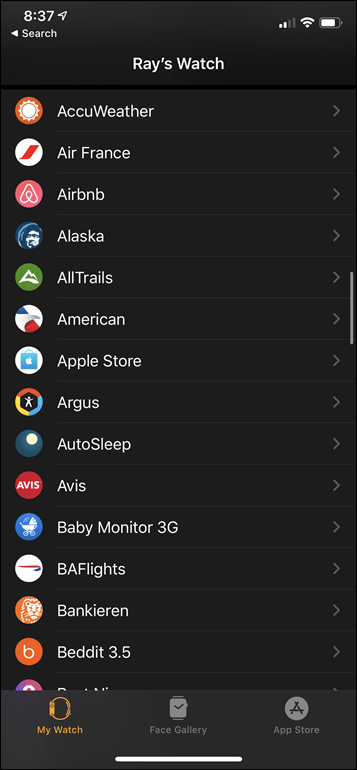
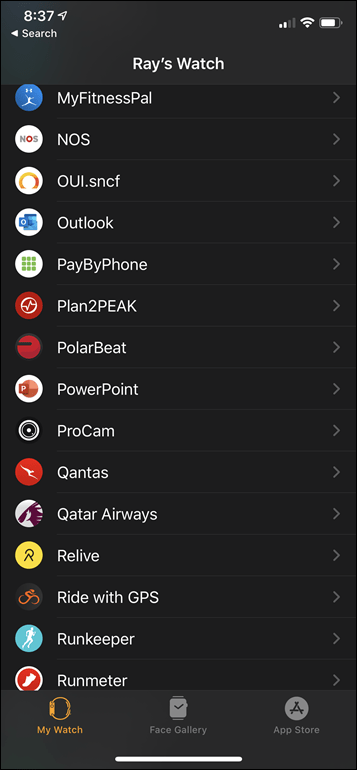
Still, the trend in 2019 was definitely not expansion of watch apps. In fact, we’ve seen and heard some big names decide to stop actively developing Apple Watch apps, noting that people just end up using their phone instead. And I think that’s definitely true across the board – not just Apple. Wearable apps, in general, are often incredibly niche-focused. They ideally solve a very hyper-specific problem where it wouldn’t be faster to reach into your pocket to grab your phone. Or, where taking/using a phone is impractical (like, surfing). Or – oddly enough, fitness apps (which we’ll get to). For everything else like reading the news, grabbing your phone just works better.
When it comes to activity, Apple uses a three-color ringed approach to monitoring your daily activity levels. These rings have daily goals, and complete a circle (ring) each time you achieve that goal. For example, the blue standing ring is goaled by default at 12 hours of standing. Which means you need to stand once every hour, ideally 12 hours of the day. The pinkish-red is for ‘Moving’, and the green is for ‘Exercise’.
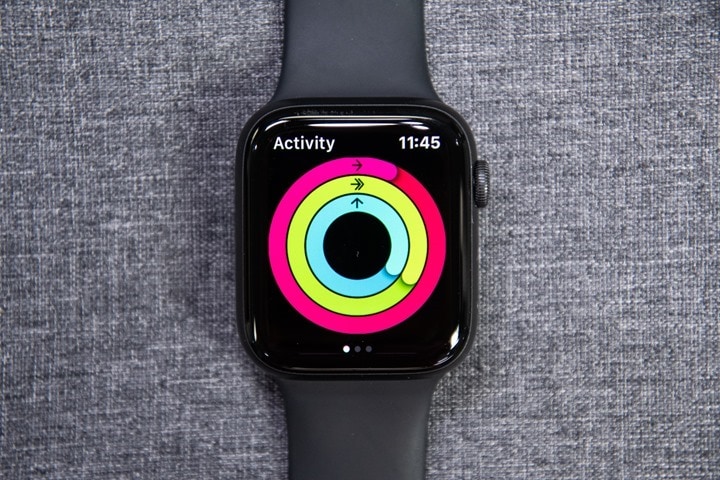
You can swipe down on this watch-face to see how it has trended over the course of the day:
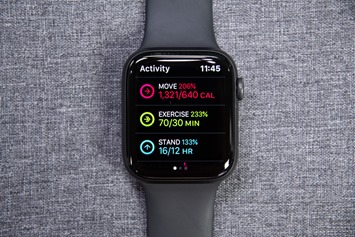
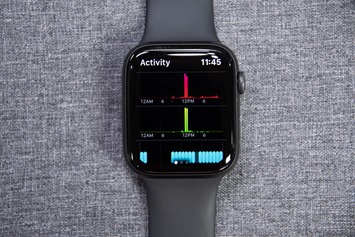
And then all of this is available on the companion app – called ‘Activity’ on your phone:
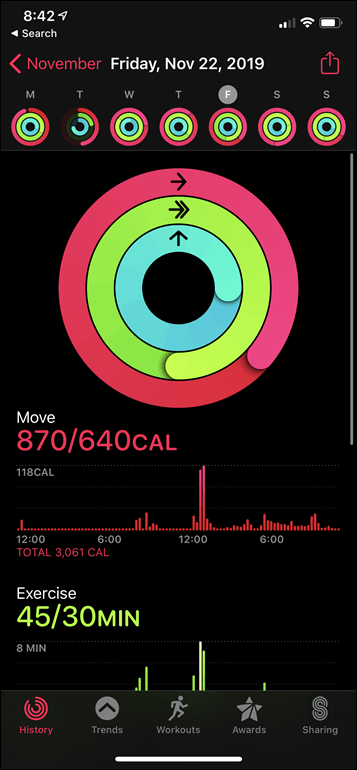
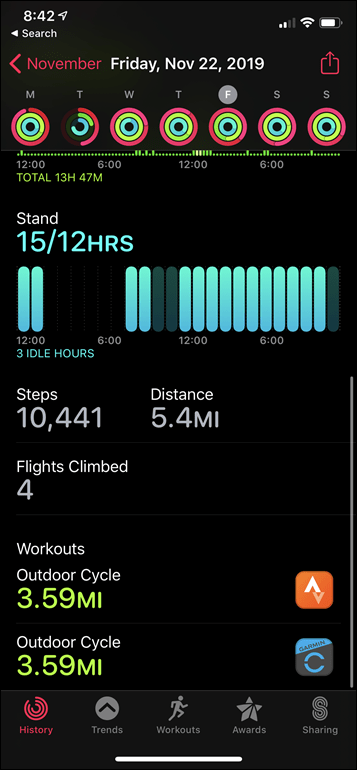
In fact, one of the new areas on WatchOS6 is the addition of a trends tab. This tab is supposed to tell you trending information about your health stats. Except, it doesn’t activate until after *6 months* of usage. For real, it even says so on Apple’s Support site:
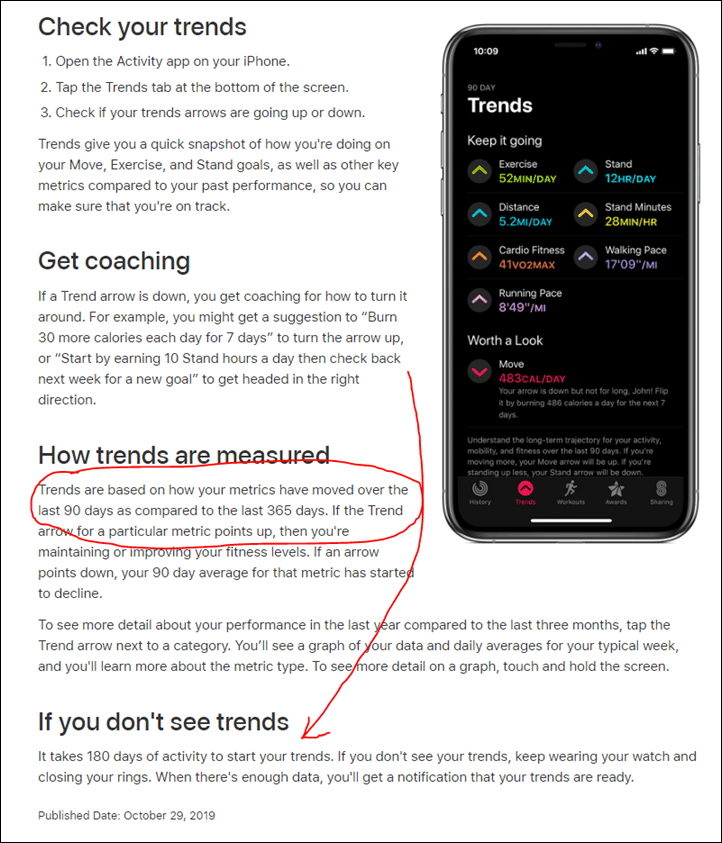
So, despite wearing the Series 5 for now exactly two months, it’s still blank (we’ll ignore the fact that for running pace, it just picks random-ass numbers):


Which is frankly unacceptable. There isn’t any algorithm math here when it does work. It’s just showing you basic graphical trends according to Apple. Why on earth do I need 6 months of data for this? Every other company in the space is able to show this type of information near immediately.
Sure, I totally understand that after a longer period of time the data gets better – the trending gets better. But 6 months is laughable. I can’t think of anything in the fitness world that says you need to wait 6 months to see *any* data. Can you get longer-term trends in 6 months? Again, of course. But you can also get perfectly usable trending in even just a few weeks. After all, Apple’s own ‘Activity’ app on the watch reminds you of this daily with streaks and such. Plus, if you tap into one of these, you can see it has all the data just fine:
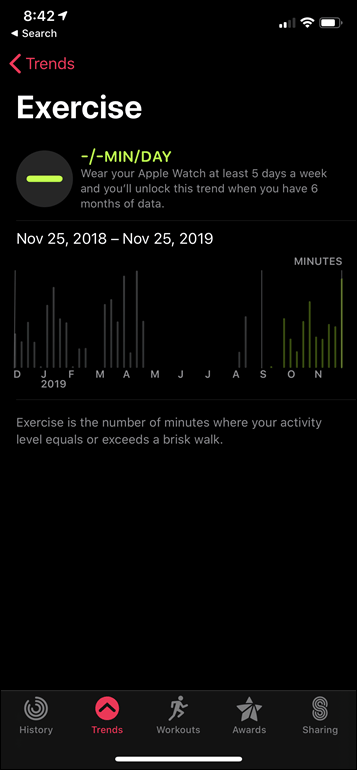
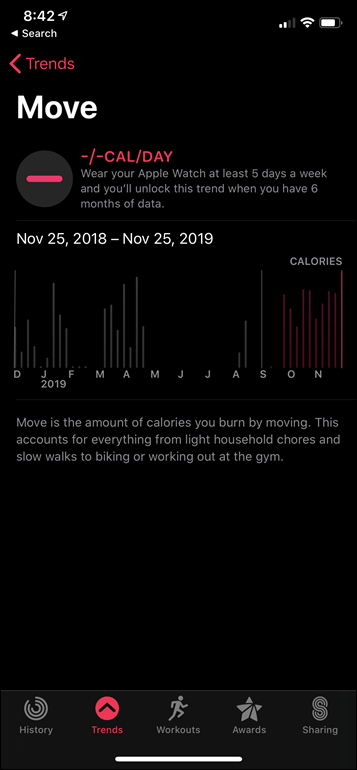
Now, despite the Activity app falling short here – Apple also updated the ‘Health’ app too with iOS13. Historically that’s been more of a database of your health data than a great place to get glanceable information. While all of the data is still there (and easily accessible), the app now has much better access to some of these overarching summary ideas and trends:
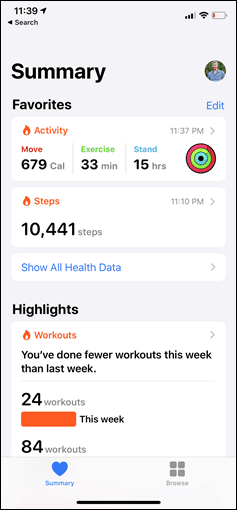
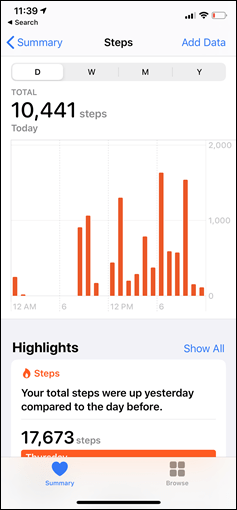
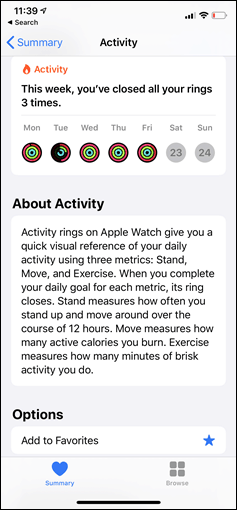
In any case, back in the Activity app, the next tab you have is workouts, but the entire next section is dedicated to workouts. So we’ll skip to ‘Awards’ – which shows you various badges you’ve earned over time. In my case I have a fun collection of badges I earn roughly each fall when I start wearing the Apple Watch for my annual reviews. Sometimes I’ll dive back into it at various points throughout the year in between other reviews.
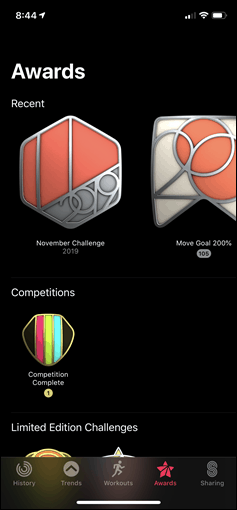
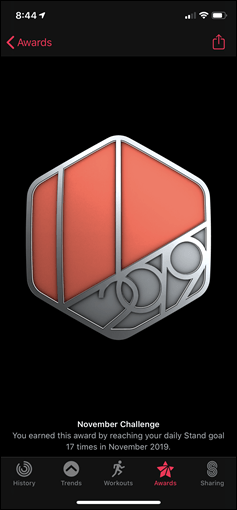
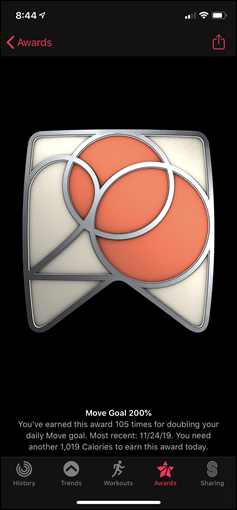
It’s on the next tab (Sharing) that you can share your data with friends and compete with them. In my case, I don’t have too many friends still wearing their watches. You can create challenges as well from here. But the last time I did that I lost the challenge. So obviously, I’m not doing that again. For the most part though the challenges are fairly basic compared to those from Garmin or Fitbit (especially Fitbit), but, they nonetheless accomplish their ultimate goal: Tricking you into being more active under the guise of besting your friend.
Finally, there are a handful of health and fitness-related settings you can tweak. These largely center around reminders or notifications. For example, you can get reminders for the ‘Breathe’ app, which will walk you through guided breathing for a few minutes. Or, you can set up notifications for low (or high) heart rate alerts, as well as irregular rhythms. That piece tends to fall more on the medical side though.
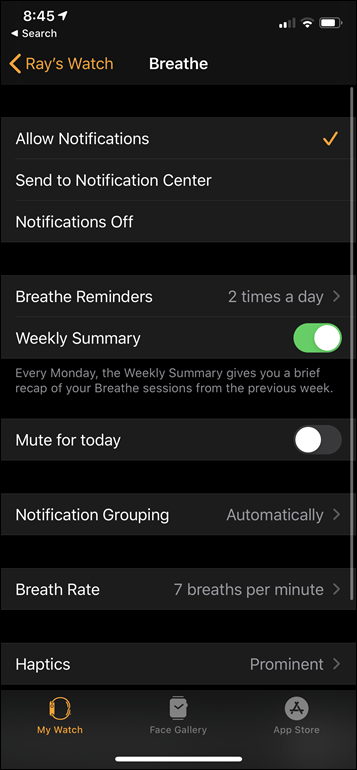
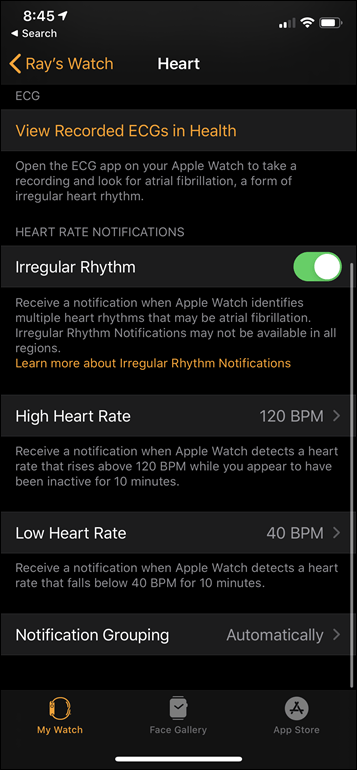
And assuming you’re in a country that permits it, you’ll have access to Apple’s ECG functionality, which they launched last year in the US and this year in Europe and a few other locales. To enable that you’ll open the ECG app on your watch and then hold the digital crown with the other hand.
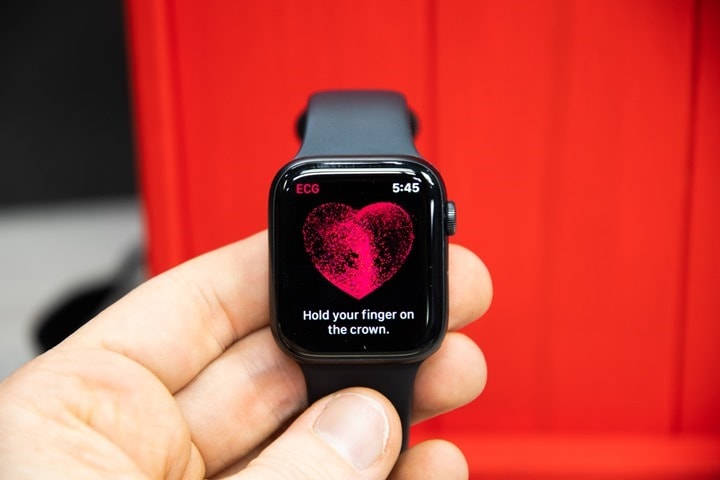
During that 30 seconds it’ll perform the ECG, all while showing you a pleasing animation.

At the end of it, it’ll spit out your results, and also file a more detailed report on your phone that you can send to a doctor in PDF form.
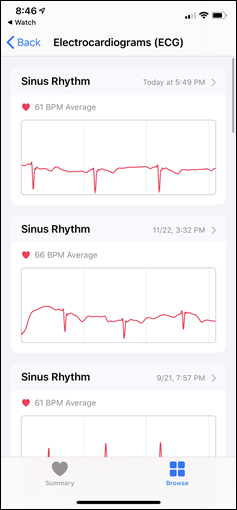
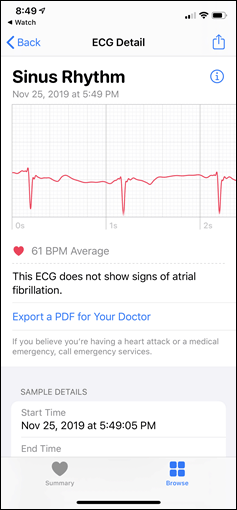
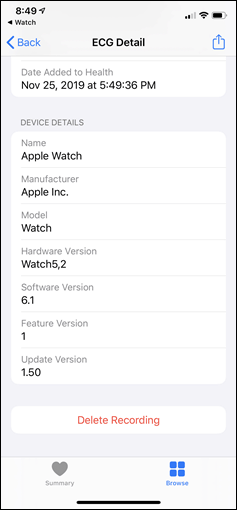
It’s smooth and functional. For most people though, it’s a feature you’ll use once and likely never again (until you find it on a random evening sitting bored on a couch and then do it again). Which doesn’t mean it’s not valuable – it absolutely is, and absolutely is making a difference. However, I’d be hesitant to buy the watch just for that specific feature unless you have a health condition that said feature would be used regularly. Still, I like to see companies push the boundaries. And especially Apple, due to their scale here.
With all the basics out of the way – let’s dive deeper on sports.
Sports Usage:
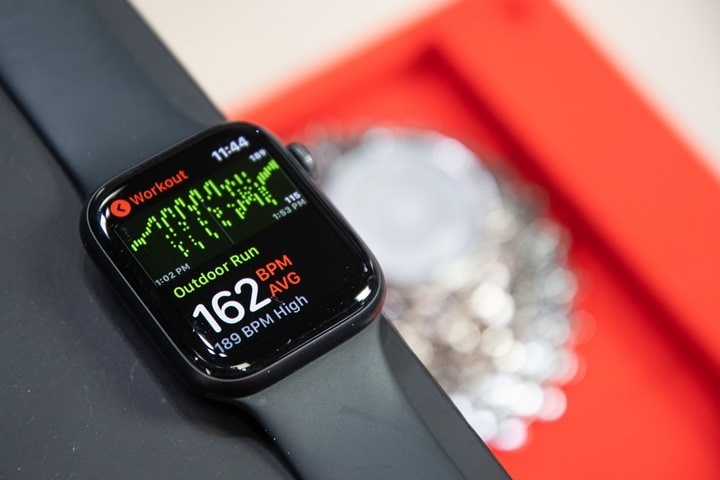
For this section I’m going to focus primarily on the built-in apps. I know there are lots of great apps out there that do great things with workouts. For example the ability to get coached workouts, highly structured workouts, more sensor support, course routing, and plenty more. And I talk about some of those later in this post. But, for the vast majority of people, they’re going to use the default apps for capturing workouts.
Still, let’s start with the basics first – and that’s getting the workout app opened. The workout app is the yellowish-green one below:
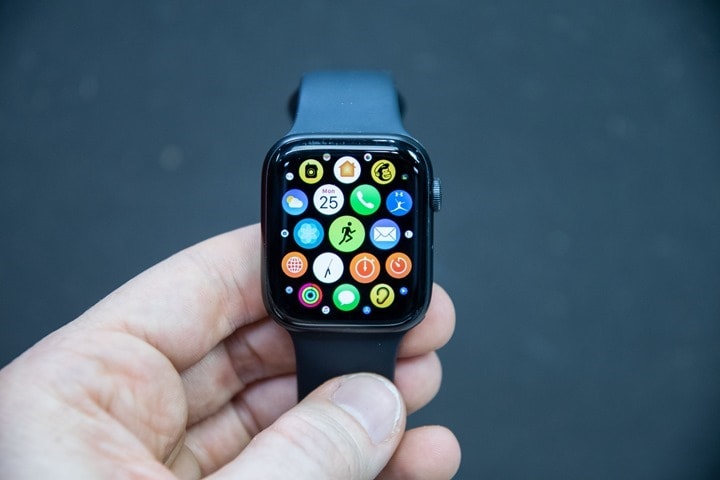
After which you’ll see a list of sports you can choose from. If you tap on the three dots in the circle, it’ll allow you to customize the goal of the workout. By default when it says ‘Open Goal’, it means you’ll do the sport for as long as you want, or until you collapse it.
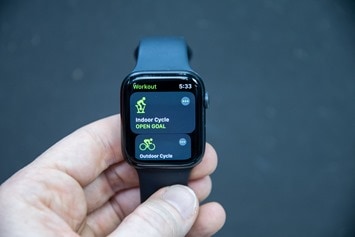
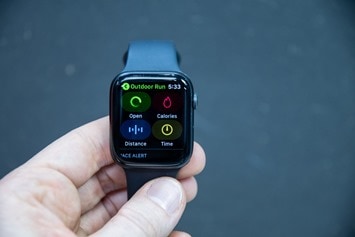
In addition, it’s here that for certain sports (like running), you can set a pace alert. You can even apply it to the rolling or average pace as well, if you want to.
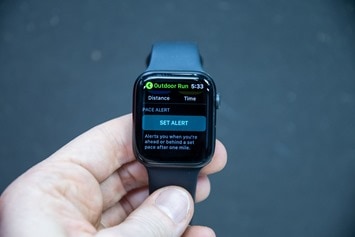
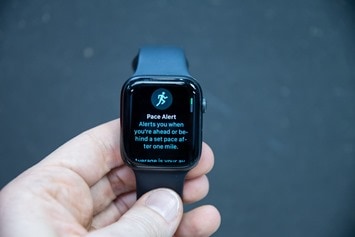
The initial list of sports are as follows (the same as from the Series 4): Outdoor Walk, Outdoor Run, Outdoor Cycle, Indoor Walk, Indoor Run, Indoor Cycle, Elliptical, Rower, Stair Stepper, High Intensity Interval Training, Hiking, Yoga, Pool Swim, Open Water Swim, and Other.
However, you can then go down further on the app and choose ‘Add’, which brings up another massive list of additional sports.
You can customize various settings via the Watch app on your phone. These include Running Auto Pause, Power Save Mode (turns off optical HR), Start/End of Workout Reminders, as well as workout playlists. I personally leave the power save mode and running pause off, since I want all the data!
Also, if your gym has gear that’s compatible with Apple’s GymKit functionality, then you can utilize that as well. No such gym that I belong to has that though unfortunately.
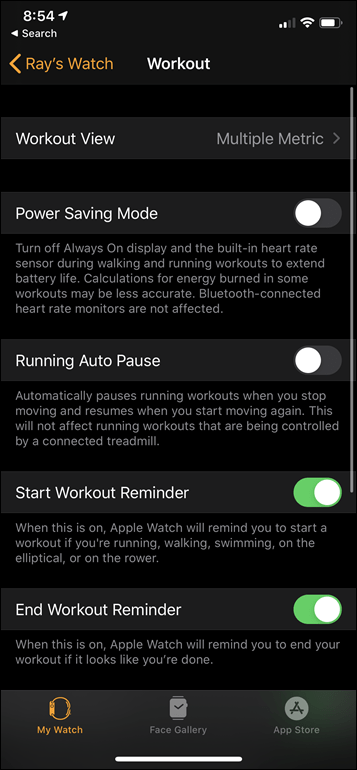
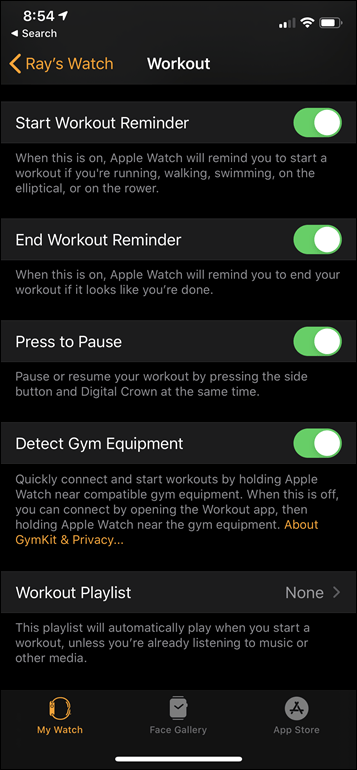
For each of the workout types, you can select the data fields you want displayed, as well as whether you want multiple metrics on a single screen or have them on a single page individually. Both are within the ‘Workout view’ option. You can select up to 5 custom metrics to be included:
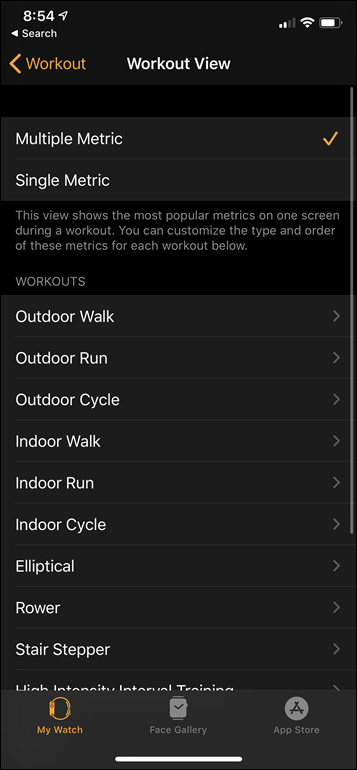
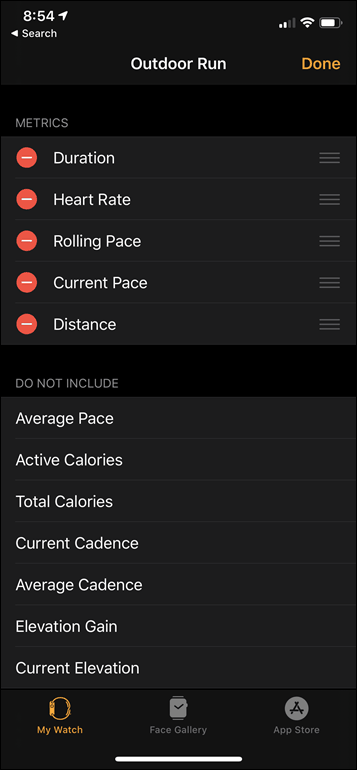
Rolling pace is one of my favorites for longer runs (but not intervals), as it allows you to see the rolling pace over the last mile (or kilometer). That’s different than something like a lap-average, because if you just start a new lap that resets the average and might not give you a good indicator of how well you’re pacing over a longer time period (like a mile).
In any case, with everything sorted, head back to the watch and press the sport name again and it’ll start a three-second count-down:
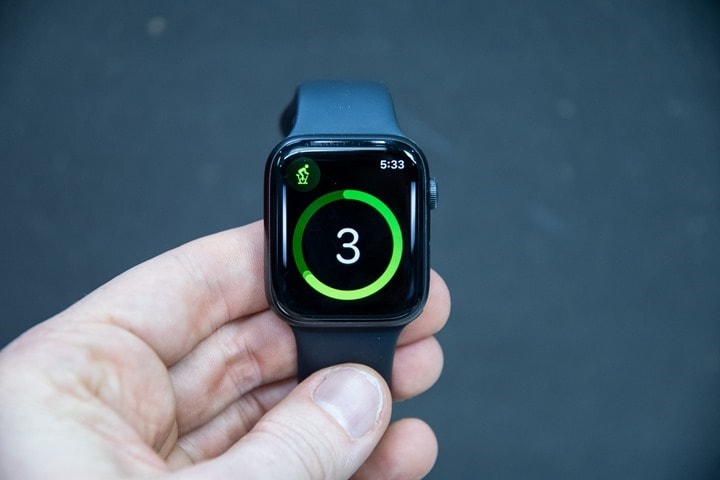
Now just like last year, it’s during these three seconds that the most ‘controversial’ element of the Apple Watch comes to light. And by ‘controversial’ I mean that most tech reviewers skip right over it, but it’s what fundamentally separates the Apple Watch from all other fitness wearables today. And unfortunately, not in a good way.
See, normally when you have a fitness GPS watch and go to the sport modes two distinct things happen:
1) GPS acquisition begins: It goes out and finds satellites. In most cases this only takes a few seconds with newer watches. But it could take longer in tough locations like NYC. If your phone is nearby, however, Apple uses the phone’s GPS instead. I will repeat: The Apple Watch will *always* use your phone’s GPS instead of its GPS unless the phone isn’t accessible.
2) Optical Heart Rate acquisition begins: While Apple is constantly monitoring your HR in a 24×7 mode, it’s actually doing so with a different set of lower power sensors to save battery life. When you go into workout mode it switches things up and needs to reacquire the heart rate with sensors and algorithms more attuned to hard workout activities (this is actually normal for many wearables). Sometimes this will happen in a few seconds, other times it’ll take 1-2 minutes.
Both of those tasks take time. But Apple doesn’t think time is sexy, so it just counts to three like a toddler and hopes for the best. After which off you go thinking that everything is ready. But in reality it almost never is. So you get gaps of data instead. You’ll notice your heart rate isn’t displayed initially (last line):
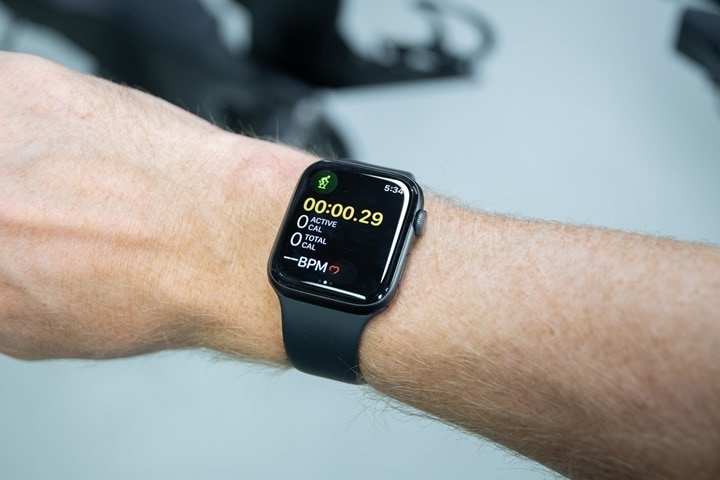
In fact, if you look at charts for the heart rate over the first 90 seconds, it’s often missing entirely, or they’ll substitute a fake value until they get HR lock. This tends to be exaggerated in running, whereas something like an indoor spin bike or trainer, tends to lock faster (due to less movement).
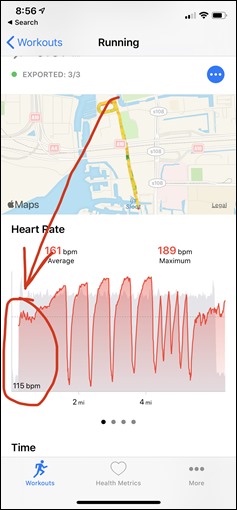
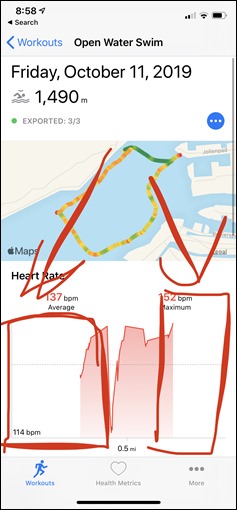
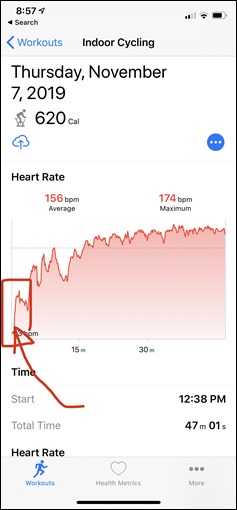
What’s funny about this (and this was the same the last two years) is that the act of not waiting actually increases the inaccuracy. It makes it harder for heart rate to acquire, and harder for GPS to acquire. In reality, if Apple were to just show GPS/HR status icons like every other watch – then you might wait a few more seconds but your data would be present and accurate.
Still, that’s not sexy and polished like the Apple mantra. And you think this focus on sexiness ends here? Nope, Apple actually fictionally smooths your corners in GPS tracks to make them look sweeping and majestical. But only in their own app. Check out these side by side GPS tracks between the Apple Watch and a Garmin and Suunto watch. Note where I enter/exit the looped track, the Apple Watch makes sweeping curves (I didn’t run that way). If you look at the satellite imagery, you can see quite clearly that’s not where the path goes. It just swoops around it.
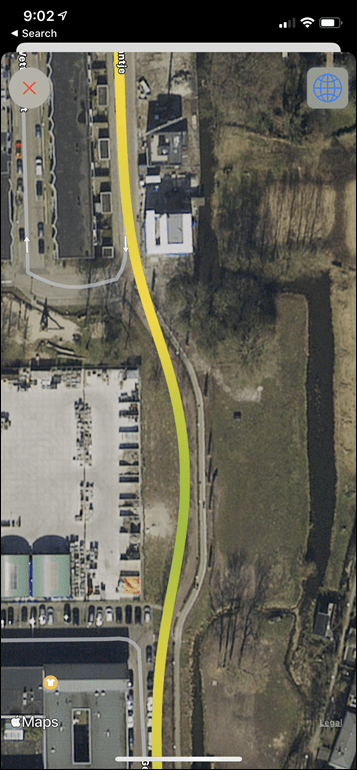
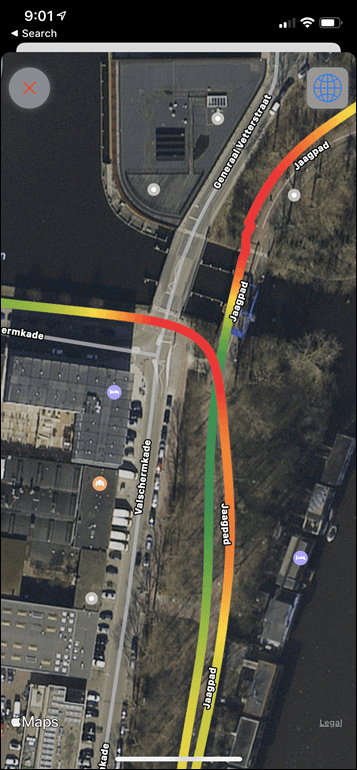
Now to Apple’s credit, this has gotten slightly better over the last year – we saw some changes earlier this year that helped a bit. But the above are screenshots from the last couple weeks on the most current firmware. Apple’s clearly trying to find balance here between the occasional mess that is GPS precision, and just showing you something that is cleaner. For example, you can see at this juncture it does make a nice sharp turn (even though it still gets the path wrong on the example to the right). It seems like Apple has worked to improve these sorts of sharper turns, but still lets the more ‘flowy’ GPS track offsets occur.


I do actually think they’re getting closer to that happy-state, but it’s not quite there yet.
In any case, we’ll talk more about accuracy in a moment (both heart rate and GPS). In the meantime, back to our run. As you remember we were just starting it before I got sidetracked. Once running (or riding or whatever) you’ll see your stats displayed.
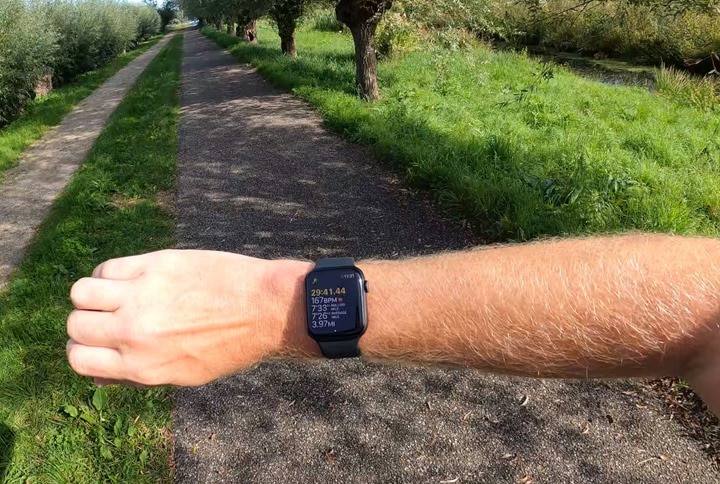
With the default app you don’t really get a ton of stats. If you want more stats you’ll want to look at 3rd party apps like iSmoothRun for example. However, there’s a catch with that: None of those 3rd party stats can utilize the ‘Always-On’ display. So while during a workout with the native Apple Watch app you’ll be able to see all the data metrics, even when your wrist isn’t raised – that same isn’t true for 3rd party apps.
For example, let’s say you use the Strava app. This is what happens when it doesn’t detect your wrist being raised – it’s just fuzzy:
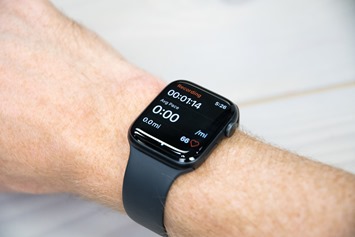
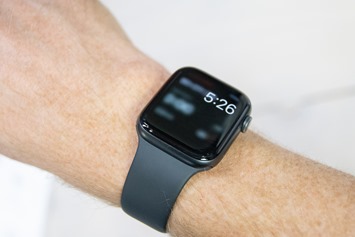
And the same is true of *every* 3rd party app, because Apple doesn’t support always-on mode for 3rd party apps. Here’s a workout app I used to collect power meter data showing the same view:
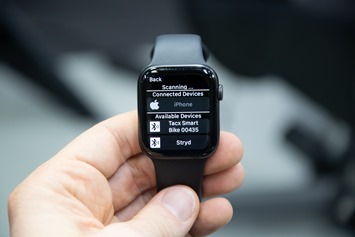
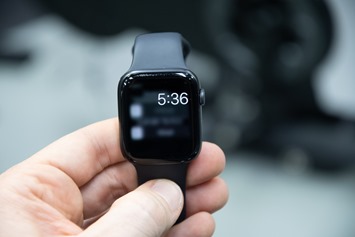
Back on Apple’s app, if you’ve enabled features like auto-lap, it’ll trigger notifications every kilometer or mile (I have mine set for every mile). Note that the Apple Watch can connect to 3rd party Bluetooth Smart heart rate straps, in the event you don’t trust the optical HR sensor. It cannot connect to ANT+ straps though. Of course, many straps these days are dual ANT+/Bluetooth Smart, so it’s really not an issue.
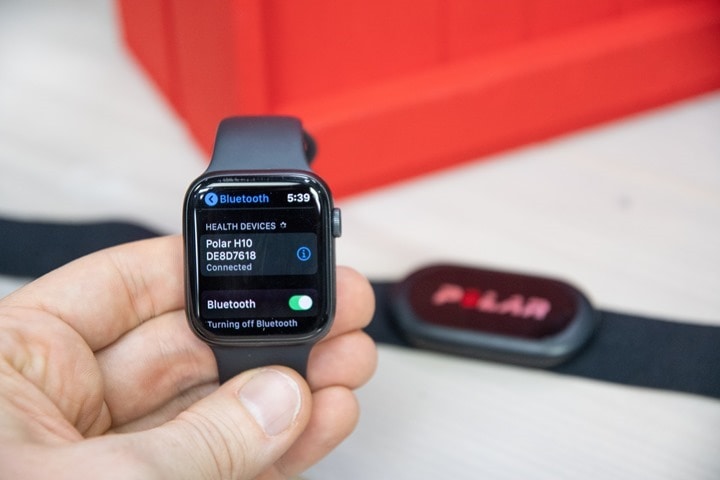
For sports like pool swimming, it’ll ask you to confirm the pool-size. Pool swimming won’t use GPS of course, but rather the accelerometer internally, so it needs to know the length of the pool to be able to determine the total distance. And for all swimming, including openwater swimming, it’ll let you know that the touchscreen will be locked until you rotate the digital crown.
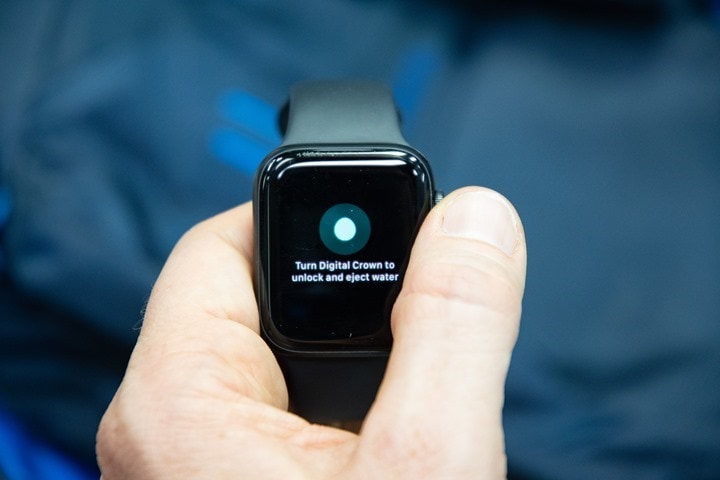
I’ve used it in both pool and openwater swimming. I’ll cover the openwater bits a bit down below.

No matter the type, once you’ve completed the workout you’ll get a summary page that you can look at. And you can dive more deeply into certain areas like heart rate stats as well from the watch.
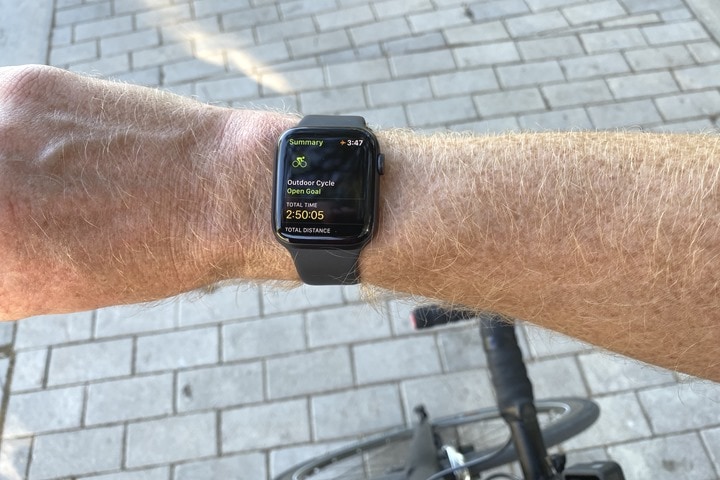
Additionally, if you switch back to the phone app you can get more stats, including splits and a map of your route:

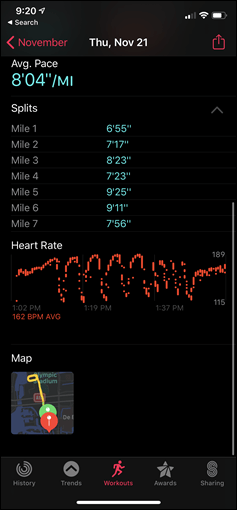
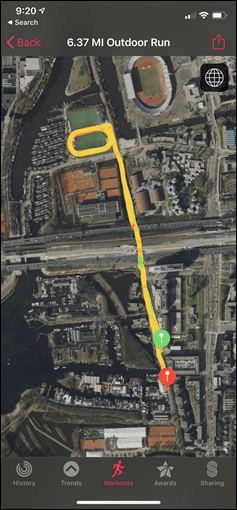
As I’ve noted in the past – most of this information is fairly basic in comparison to what other companies provide in the space, especially sport-specific companies like Garmin, Suunto, and Polar. You won’t find things like advanced recovery metrics, or training load. None of that makes it into the default Apple Watch experience. Some 3rd party apps have more details, but again, not Apple themselves.
And that’s probably just fine. Most people don’t care about those metrics, and thus it doesn’t really fit into the Apple-like realm of ultimate simplification for the widest possible audiences. Apple will sell tens of millions of these watches this year, and only a small fraction of those people will actually use the workout modes regularly.
Still, I’m surprised that we’ve yet to see Apple add any basic interval or structured workout support. After all, Fitbit has seen good success there. And even more so as companies (including Fitbit and others) have looked to add basic coaching type capabilities to mainstream wearables. Apple would likely contend that’s why they have such a vibrant app store with so many options. And again, I’m also not sure they’re wrong here either – but in my opinion they just leave the door open.
In comparison, Garmin’s millions of units per year are small – but they’re also potential revenue for Apple. A slight nod to workout routines would be at least some new feature for the WatchOS crowd, which aside from a couple of very minor new tweaks, hasn’t actually seen much in the way of sport/fitness newness in a few years now.
Data and Apps:
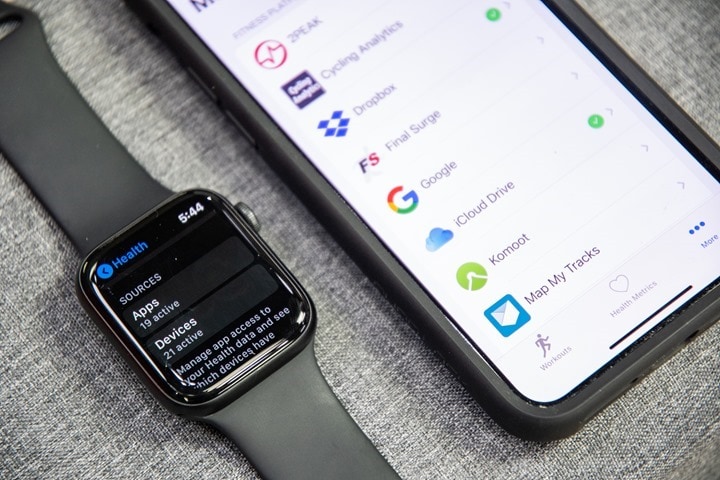
One of the things that makes the Apple Watch so appealing is the app ecosystem. The vast majority of apps you’ll use day to day seem to have some sort of Apple Watch companion app with it. Some are very basic offering no practical added value, while some are extensive and eclipse the phone app itself in value. And with WatchOS6, we’ve seen Apple now allow apps to be installed directly from the watch itself. I suspect that’s a move to eventually enable Android connectivity in future iterations – a theme that would be highly consistent with Apple’s branching out beyond the walled garden of Apple (see: Apple Music, Apple TV+, etc…).
However, despite that, there’s still challenges to that wall. Inside those walls is a vibrant garden. And in fact, the data and organization is astonishingly accessible to you as a consumer. Well, mostly. At least until you try and take that kiwi out of the garden, then it requires a maze of hoops. But we’ll get to that in just a moment.
All of the fitness/sport/health data goes into the massive repository that is Apple Health, which is accessible to apps (with your approval) via HealthKit. Note that this is kept entirely on your device. There is no cloud service or online platform for Apple Health data – a key differentiator (good and bad) from other companies’ platforms (though, you can backup/restore it via iCloud as part of your normal iPhone recovery process).
For most data, you can view it directly in Apple Health, via the ‘Health’ App on your phone. Some of this data, like steps and stand hours, have nifty graphs:

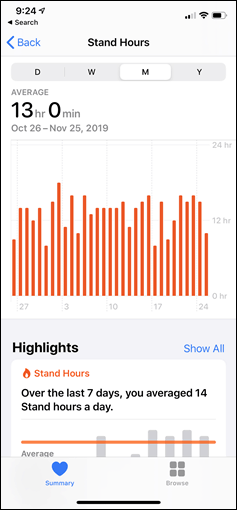
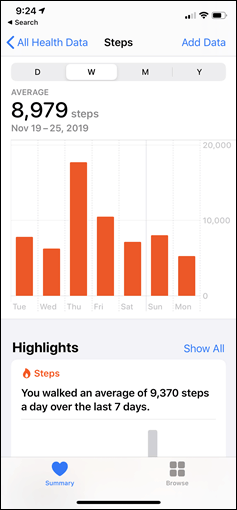
But lots of the data is a bit more nuanced in nature and dumped into huge database tables, though, you can still view those too:

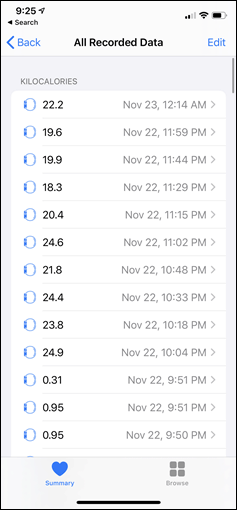
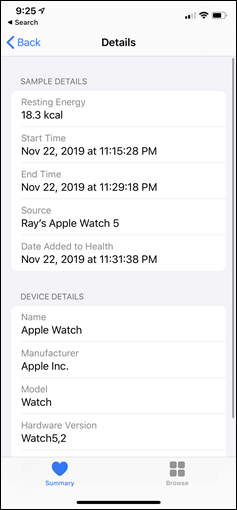
In fact, you can see how each device I use contributes data. For example within this walled garden, Apple & Garmin actually play surprisingly well to contribute data to my day. Garmin for example can send in sleep data, while the Apple Watch adds in ECG data. Two sources can also blend their data too. While from an industry fitness standpoint it can be frustrating (as it utilizes zero standards for how to transport fitness/sport data), the actual data there is incredibly powerful.
But….what if you want to get it out? What if you want to get that workout you just did on your Apple Watch using the native ‘Workouts’ app and send it to Strava? Or TrainingPeaks? Or Dropbox?
There’s a few apps for that – but the one I keep going back to is HealthFit. It supports sending to boatloads of data partners, and does so in a way that conforms to standards, namely the .FIT file.

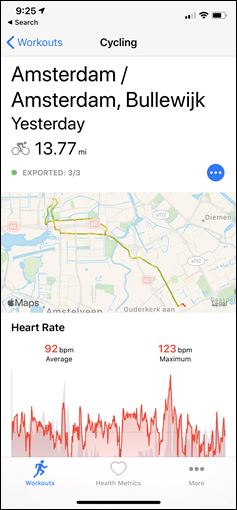
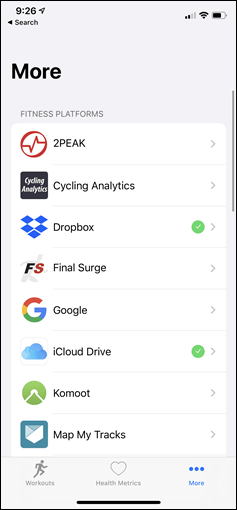
You’ll see your workouts enumerated from the Apple Health database, and you just select which ones you want, and off it goes uploading them. Up until this fall it used to do that quietly in the background, but Apple changed some permissions model that restricts how frequently apps can tap into HealthKit in the background, so now you’ve mostly got to do it manually. Though it’s no big deal.
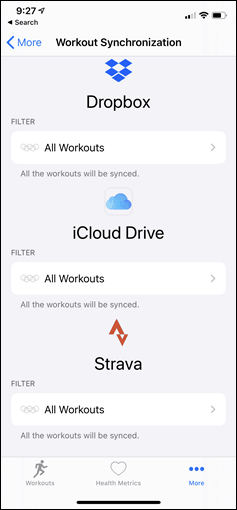
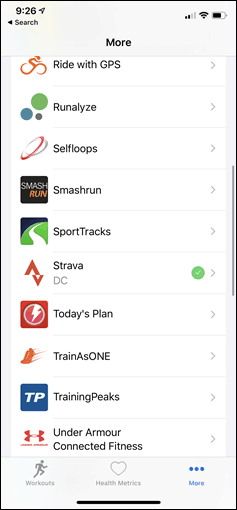
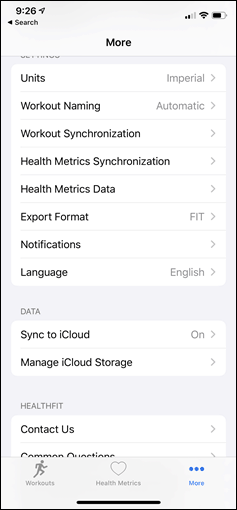
I use this app for all of my Apple Watch data needs. For example, all of the data in this review pipes through that app (as there’s zero other ways to get it). And even my ride yesterday using the Apple Watch I did with the native app, and then used this app to upload it to Strava. It’s 100% worth the $ 3 that it costs to get the data where you want it.
(Note: I don’t have any paid/sponsored/whatever affiliation with any of the above/below apps. I paid my own two bucks or what-not for all of them…and plenty more.)
The next app that I used was to record cycling power meter data. Up until now, this has mostly been impossible to do on the Apple Watch itself, without having your phone nearby as a conduit. Meaning, there were apps that allowed you to display cycling power meter data on the watch, but they all required your phone be there to make that connection. However, the Train2Peak app now has that capability entirely within the Apple Watch app (and isn’t limited to just Series 5). Here you can see me pairing it to my Garmin Vector 3 power meter:
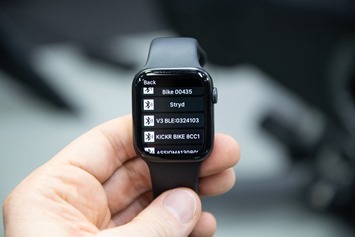
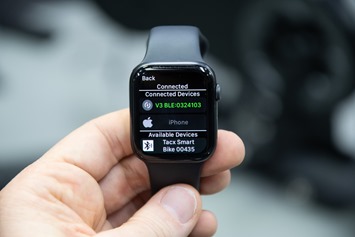
And then here I am mid-ride:

The interface to start a ride can be a little bit slow/cumbersome, but that’s honestly largely a limitation of the Apple Watch platform/user interface by the looks of it. And once the ride is started, off it goes recording it perfectly fine. The data has exactly matched while I was riding compared to my Garmin (over Bluetooth Smart). Afterwards the data syncs both to their cloud platform, as well as into the Apple Health database, and you can also export it via e-mail or to Strava.
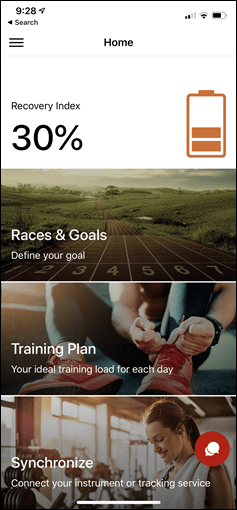
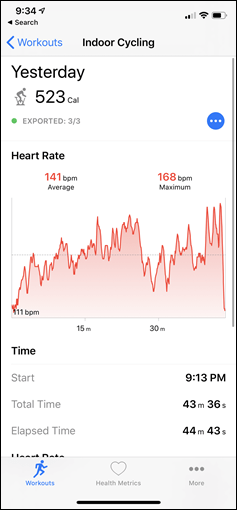
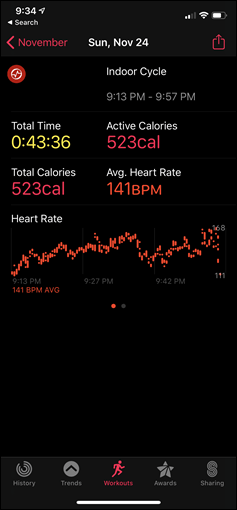
Finally, there are a few apps I’ve used successfully in the past, though didn’t use this time around. The reason I didn’t use them doesn’t mean there’s anything wrong with them, they’re still great and well-maintained apps.
WorkOutDoors: This is mapping/navigation focused and allows you to download a map segment to your Apple Watch for navigation. You can import in tracks/routes and then follow those tracks against the map on your watch. Basically, it’s like having a mini version of a Garmin Fenix series watch. Cool stuff.
AutoSleep: So this app allows you to get sleep data on your Apple Watch. Unlike many apps – this requires zero end-user interaction. Some apps require you to ‘start’ and ‘stop’ your sleep, which I find silly and 1980’s like. This just does it all in the background magically and then you use the iPhone app to view the data. Sweet!
RunGap: This app is somewhat like HealthFit above. It allows you to upload/export to various services as well. I haven’t used this one as much merely since I’ve mostly just used HealthFit. I’m kinda a ‘if it works don’t try and fix it’ kinda guy. Though I know plenty of people use RunGap, here’s a bit of a review from last year – but one from a source I trust that walks through the functions.
Finally, one general caveat when looking at Apple Watch apps is to ensure the app is able to function in a standalone non-phone connected manner. Some apps have features that only work when in connection with a phone nearby (such as connecting to certain sensors), while other apps can be fully freestyle and go tetherless. A great example of that is the Spotify app. Yes, Spotify can indeed be installed on the Apple Watch. Except one itty-bitty caveat: You can’t download music to it. It’s just for controlling your other devices.
One quick and easy way to test whether something depends on your phone is to turn off Bluetooth on your phone (via the Bluetooth control panel, else it’s not really off). Or, just stick your phone in your microwave (don’t press start!!!) – which creates a signal-jamming bubble around it.
GPS Accuracy:
There’s likely no topic that stirs as much discussion and passion as GPS accuracy. A watch could fall apart and give you dire electrical shocks while doing so, but if it shows you on the wrong side of the road? Oh hell no, bring on the fury of the internet!
GPS accuracy can be looked at in a number of different ways, but I prefer to look at it using a number of devices in real-world scenarios across a vast number of activities. I use 2-6 other devices at once, trying to get a clear picture of how a given set of devices handles conditions on a certain day. Conditions include everything from tree/building cover to weather.
Over the years, I’ve continued to tweak my GPS testing methodology. For example, I try to not place two units next to each other on my wrists, as that can impact signal. If I do so, I’ll put a thin fabric spacer of about 1”/3cm between them (I didn’t do that on any of my Apple Watch Series 5 activities however, all workouts only had a single device per wrist). But often I’ll simply carry other units by the straps, or attach them to the shoulder straps of my hydration backpack. Plus, wearing multiple watches on the same wrist is well known to impact optical HR accuracy.
Next, as noted, I use just my daily training routes. Using a single route over and over again isn’t really indicative of real-world conditions, it’s just indicative of one trail. The workouts you see here are just my normal daily workouts.
I’ve had quite a bit of variety of terrain within the time period of Apple Watch testing. This has included runs in: Amsterdam (Netherlands), French and Swiss Alps, and Mallorca (Spain). Cities and mountains, trees and open-air, plus waterways and seas. It’s hit them all.
First up we’ll start with something relatively easy, a run south from Amsterdam. On this initial test I’ve got a mere five GPS devices, three of which are attached to a running stroller, and the remaining two (including the Apple Watch Series 5 and Garmin Venu) are on my wrist. Here’s that data set:

At a high level, things look mostly fine. But let’s dig into the weeds. No, really, the actual weeds. To the right of these tracks is a pasture where horses hang out. In the below case, the Garmin FR945 is almost perfectly atop the running path. You’ll see the Garmin Venu is off to the right, while the Apple Watch is off to the left. The Garmin Venu is slightly more offset than Apple, but Apple cuts more corners.

If we got a bit further in the run, you can see this play out again. That white line is the actual path I ran on (and if I toggle to satellite view, it matches there, it just makes this picture harder to see due to the trees). You see that the Venu is super close here, whereas the Apple Watch cuts the corners nonchalantly. Which isn’t as bad as the COROS Vertix and FR945 being offset entirely (way into the woods).
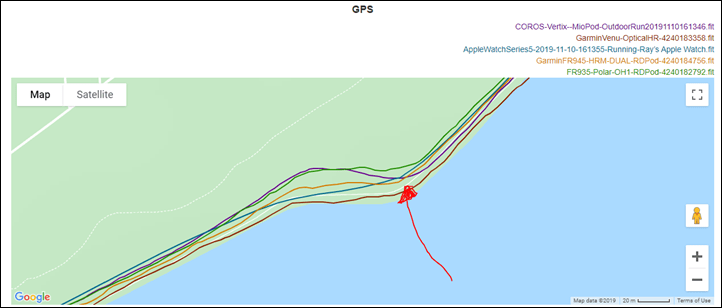
See, one exhibits a track offset (whereby it mirrors the turns, but doesn’t match where you went), while the other simply cuts corners. You see it again here on this next corner:

And again this mess of a loop here. Apple cuts the corners, and Garmin is off in the drunk. Equally bad, just bad in different ways.
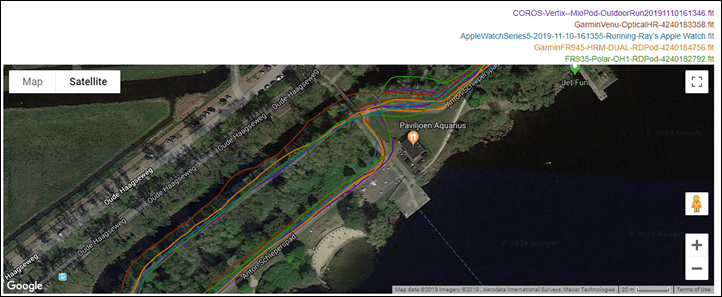
Now…this is nitpicking. No doubt about it. And at first glimpse it might not seem so bad. But then you look at the total distance and realize it all adds up. Every Apple overshoot adds up eventually (despite the cut corners). It’s nearly 300m longer after 10KM than the others.

I normally hate showing total distances, because you can be wrong 100% of the time and still get distance right (via enough corners/overages). But generally once we get this many units at once, there’s definitely something to patterns.
Next, let’s look at something a bit simpler: A track workout.
Technically it’s both a track workout and testing the ability of this watch to draw a straight line. The path I ran down is precisely straight. Crazy straight in fact. I take it every single day to and from work. It’s great…and goes under a gigantic ring highway that loops around the city – perfect for testing GPS re-acquisition. Here’s the high-level overview, and data set from just a few days ago.
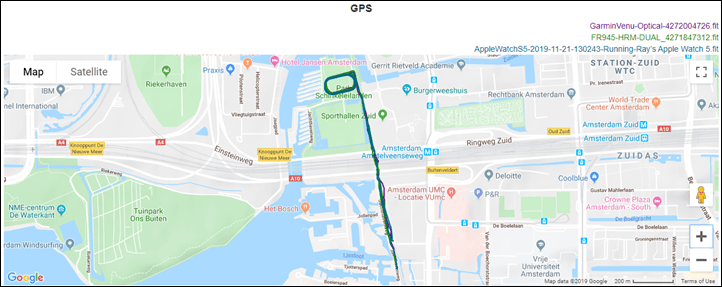
Let’s zoom in first to that massive bridge set. This includes two railroad bridges along one of the busiest rail corridors in Europe. Plus two highway overpasses. It’s hundreds of meters wide. And, for the most part all three units handled it just fine. The Venu did stumble very slightly coming back out one direction, but not significantly.

As for the straight section? Hmm…not so hot. At least not initially. From the outside they were a bit rough, but as they returned an hour later, they were much closer. This path is technically tree-lined on both sides, so that probably wasn’t helping matters.

So the big moment – the track itself? For this I stayed exactly in Lane 1 (there was nobody else there), and round and round I went. About 10KM of round and round worth. I want to point out three things. Actually, four things, but with three arrows.
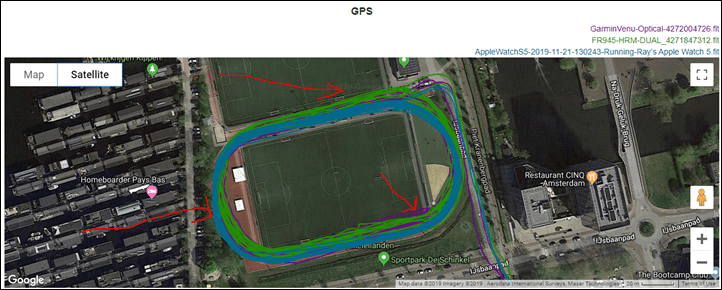
First off, before I do that – note that no matter how good your GPS is, in 2019, I still recommend doing track workouts by just counting distance. At least for the specific sets. Meaning, you should be looking at the markings on the track to know when you’ve run 400 meters, 800m, and so on. I merely use my watch for historical data purposes on a track, as well as managing heart rate and time. I don’t generally use it for pacing via GPS (or footpod). I just do mental math.
That said, these three arrows show us four things:
1) All units were pretty darn close. Nobody was off out of the property or anything weird.
2) The Apple Watch was slightly offset to the left, you see that left-most arrow in the woods point at the Apple track.
3) The Garmin Venu took a few brief dips into the lower right infield of the pitch
4) The FR945 seemed to favor being slightly on the upper outer edge, meaning it was slightly offset a touch bit north
All in though, these results from a GPS track (as in, the line itself) are perfectly acceptable to me for historical record keeping.
Next, let’s look at another set. This time swapping out in the open water for a swim. Previously I’d have said that the Apple Watch Series 4 was the reigning king for openwater swim GPS accuracy. But, as you can see – that’s no longer the case. Here’s the data set:

Note: For openwater swims I have one watch per wrist, but then I also have a reference watch atop a swim buoy that floats just behind me a few inches.
Now, the Apple Watch didn’t make any major mistakes, and overall it’s very good. But you can see as I started off on the first crossing of the channel, it wasn’t spot-on:

It’s hard to see in teal, but it basically cuts across in the wrong spot, and then does a weird loop-de-loop on the other side. Whereas, the Garmin Swim 2 and FR945 reference track are near identical.
If we go down a ways till when I cross back over again, you’ll see a small quirk. I had to wait here a few seconds for a ship to pass through. It looks like I drifted very slightly, which both the reference track and Apple Watch Series 5 picked up. We’re only talking a few meters extra, but the Garmin Swim 2 appeared to smooth that out.

Meanwhile, on the other side of the lake when I made my next turn you see the Apple Watch cut the corner a little bit again, whereas the Swim 2 handled it nicely.

On the last buoy, I went to the left of it. Here it shows me going through it on the Garmin Swim 2, and to the right of it on the others. Of course, it’s totally possible the buoy has moved slightly. Either way, it’s pretty close for both units.

There’s some more openwater swim sets with the Apple Watch Series 5 in my Garmin Swim 2 In-Depth Review, if you want to dig in there (as well as indoor swims).
In addition, I have dug through my GPS tracks from outdoor bike rides as well (including some mountain areas), and found it pretty much fine. For example, here’s this ride in Mallorca (Spanish island) through very rocky/mountainous terrain. Here’s that file.
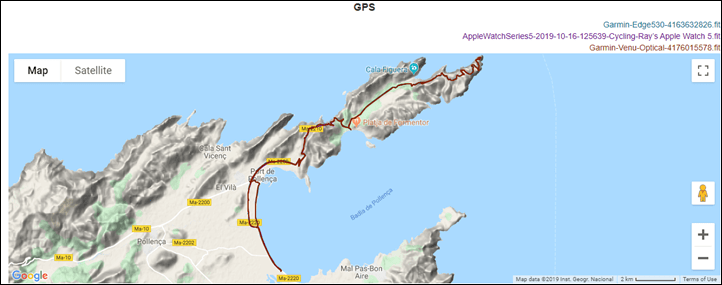
Though, there was one particular spot that the Apple Watch did struggle, which is seen below.

However, it actually wouldn’t have been the Apple Watch, but rather my iPhone 11 Pro. Remember: When the Apple Watch is within range of your iPhone, it will always leverage the GPS signal from the iPhone. This, as you can see above with that errant line, is one reason I tend to take cycling Apple Watch GPS tracks with a grain of salt. I’m almost always cycling with my phone – so it’s kinda pointless to dissect the Apple Watch tracks there.
Ultimately – what I see on the Apple Watch Series 5 is pretty darn similar to what I saw on the Series 4. It’s good, and the tweaks to WatchOS/firmware over the last year have made it better than before – but it’s still not great. I’d say Apple’s openwater algorithms are better than their land algorithms. But at the same time, for 99% of people, it’s more than acceptable.
Apple essentially trades precision for smoothness. Part of the swooping I make fun of is ultimately just Apple cleaning up GPS tracks so that the average person looking at them doesn’t pick them apart with all sorts of typical GPS noise. On the flip-side, it means corners often get cut. Apple banks on the fact that people don’t look terribly closely at GPS tracks to see the cut corners, but would instead notice more sharp GPS errors. Realistically, they’re probably right from a marketing standpoint, even if they’re wrong from a technical standpoint.
(Note: All of the charts in these accuracy sections were created using the DCR Analyzer tool. It allows you to compare power meters/trainers, heart rate, cadence, speed/pace, GPS tracks and plenty more. You can use it as well for your own gadget comparisons, more details here.)
Heart Rate Accuracy:
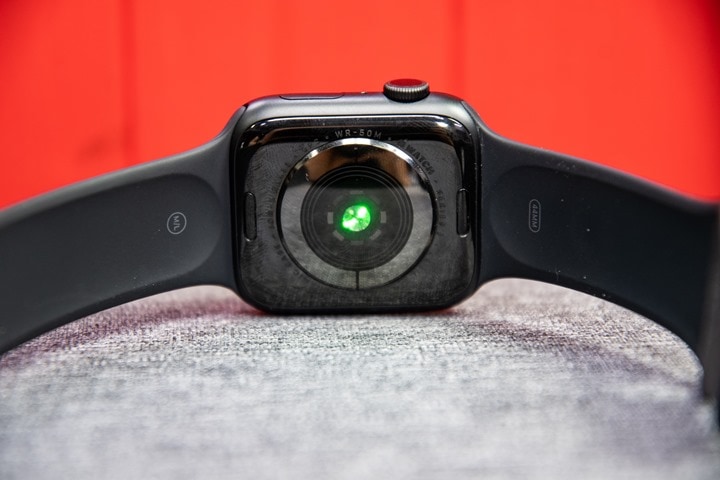
Next up we’ve got heart rate accuracy. This roughly falls into two buckets: 24×7 HR, and workout HR. As is usually the case with most devices these days, I see no tangible issues with 24×7 HR. It works well across both normal daily routines as well as things like sleep. Speaking of which, I talk about RHR values and 24×7 monitoring here and why it’s interesting.
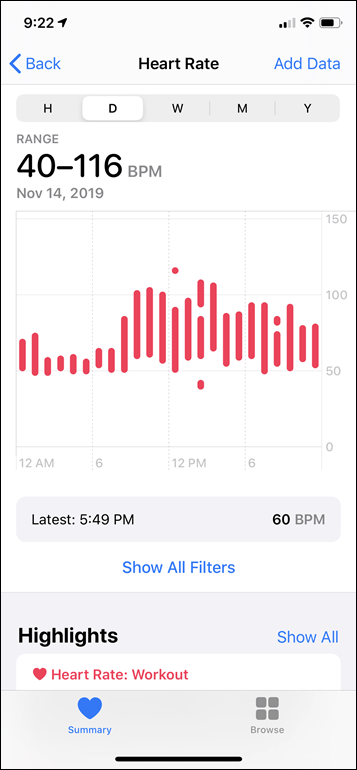

Before we move on to the test results, note that optical HR sensor accuracy is rather varied from individual to individual. Aspects such as skin color, hair density, and position can impact accuracy. Position, and how the band is worn, are *the most important* pieces. A unit with an optical HR sensor should be snug. It doesn’t need to leave marks, but you shouldn’t be able to slide a finger under the band (at least during workouts). You can wear it a tiny bit looser the rest of the day.
Ok, so in my testing, I simply use the watch throughout my normal workouts. Those workouts include a wide variety of intensities and conditions, making them great for accuracy testing. I’ve got steady runs, interval workouts on both bike and running, as well as openwater swimming – though, I didn’t focus on optical HR accuracy there.
For each test, I’m wearing additional devices, usually 3-4 in total, which capture data from other sensors. Typically I’d wear a chest strap (usually the Garmin HRM-DUAL or Wahoo TICKR X) as well as another optical HR sensor watch on the other wrist (lately the Polar OH1 Plus, as well as the new Mio Pod lately). Note that the numbers you see in the upper right corner are *not* the averages, but rather just the exact point my mouse is sitting over. Note all this data is analyzed using the DCR Analyzer, details here.
Oh – and note that I’m going to focus almost exclusively on very recent data here – meaning, all on the latest firmware update (WatchOS 6.1). Whereas my earlier impressions were on WatchOS 6. Though, I don’t think it has anything to do with WatchOS per se, but quiet and underlying changes made for Apple Watch Series 5 itself (since it wasn’t seen on Apple Watch Series 4 on WatchOS 6).
In any case, first up is a nice run south out of Amsterdam. Nothing too tricky here to begin with – relatively stable, except also pushing a stroller (which can be challenging for optical HR). Here’s data against the Garmin Venu (optical HR sensor on other wrist), the Garmin HRM-DUAL chest strap, and the Mio Pod strap on my upper arm (data set here):

The Apple Watch is the teal one. Though of course, you can’t really see that – because they’re all virtually identical.
The only difference is the chest strap struggles the first few minutes to gain lock. I had got the strap wet, but it looks like by time I got everything ready to go with 6+ devices, it dried out again. Welcome to cooler/dryer fall running days. When people talk about how optical HR sensors are always less accurate than chest straps – I simply point to cases just like this. It’s not as cut and dry as people like to make it seem.
Years ago before optical HR sensors became common, the most popular post every fall was how to troubleshoot chest HR strap issues. What’s old is new again.
In any case, the only other time we see any variance here is briefly from the Garmin Venu where it stumbles a bit within a 60-second span. This could be due to the pressures from pushing the stroller, or could be anything else. Either way, all three are very similar.

So…let’s kick it up a notch.
Interval time!
Here’s a track workout I did last Thursday, a bunch of 800’s and then a bunch of 200’s. Plus a warm-up and cool-down. Here’s that data set:

Let’s zoom right into those first few minutes

Now that’s what I’m talking about baby – that’s the Apple Watch I know and love!
(What you see above (in case it isn’t clear), is my highlighting the flat-line Apple Watch HR signal, until the 2-minute marker, where it finally finds lock).
The one that completely ignores tracking your heart rate for the first two minutes. Hell, it even had an extra 36 seconds before I started running, and it still couldn’t get lock. We’ll also ignore the fact that it had even longer than that, since I did one accidental workout just before this for a few seconds (which in my experience usually helps speed up subsequent lock).
Now yes, the chest strap also struggles initially. Again, welcome to dry fall days. Once I sweat enough a few minutes I get some sweat, probably adjusted it slightly, and life is fine. So, into the 800’s we go:

Frankly, these are pretty darn good.
I can nitpick that the Apple Watch seems a bit too high at times, and might be doing some occasional cadence-lock in some cases. And the Garmin Venu appears to be a bit slow on the recovery in some intervals. The Polar OH1 also seems a bit latent in a couple of them too. But again, by and large – any of these would be more than accurate enough to pace/train by.
So, the 200 sprints?

A bit rougher on the first one, it’s like it caught everyone by surprise. Which, is fair. It’s how I felt too. The Venu missed the boat, the chest strap nailed it, and the Polar OH1 was slow. But the Apple Watch on the first one did something really unique. Zoom on in:

It actually lost tracking, in roughly 10-second intervals. See the highlights above? Each dot is where the Apple Watch picked back up the HR signal, but in between them, it lost it, and was just connecting the dots. Normally it records at 1-second intervals. In this case, it really struggled.
On the second one, it struggled again initially, but then caught on. Each yellow mark I’ve made is where it got lock again. The gaps are where it’s missing data.

In any case, it probably wouldn’t materially impact most people during training, since nobody doing hard short 200m sprints is actually checking their heart rate during the sprint.
Next, let’s shift to some indoor cycling. This was actually a pretty intense indoor trainer workout. For context, here’s what the power output looked like:

And then here’s the matching heart rate data:

What you can (boringly) see is that all these sensors were virtually identical. The Garmin Venu struggled during the first 60 seconds or so, and then everyone settled in nicely. There were a few seconds here or there that different units briefly disagreed, but even during the sprints, the HR plots were very very close.

Overall, the early issues I saw with the Apple Watch Series 5 and HR drops or gaps appear to largely have been solved over the past two months. At this point I think HR accuracy is one of Apple’s strongest fitness aspects of their watch – bringing it back to the Apple Watch Series 4 levels.
I’m not sure that it’s the outright optical HR sensor king it was a year ago, mostly because Garmin and others seemed to have increased their accuracy. I’d say it’s roughly in the camp of being a wash. Apple loses points for the first 60-120 seconds of each workout usually being a gapped loss, while they tend to gain stability points elsewhere that Garmin sometimes loses. It appears (like GPS) that Apple errs on the side of smoothing through an unknown HR signal, versus Garmin seems to try and take a guess at it. There’s pros and cons to both.
Product Comparison:
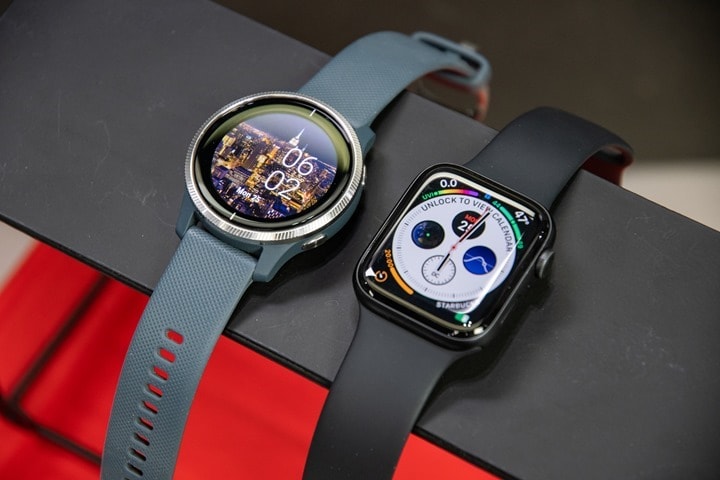
I’ve added the Apple Watch Series 5 into the product comparison database, allowing you to compare it against other products that I’ve reviewed in the past.
For the purposes of below I’ve compared it against the Fitbit Ionic, Samsung Galaxy Active Watch 2, and the Garmin Venu – which are the ones most people will be comparing it against from a sports/fitness standpoint. Also note, with a unit like the Apple Watch specifically, there are many cases below where “with 3rd party apps” can be used. The same is largely true of Garmin, Samsung, and somewhat with Fitbit. I’ve tried to thread the needle of apps that I roughly know exist where I’ve listed that. But it’s not perfection in terms of knowing every app on earth. Ultimately, I don’t think any consumer does (or should). Plus, we’ve actually seen a pulling back of wearable apps from companies over the last year (basically, they stop updating them). Making it even harder to know an up to date app from a dysfunctional one dying on the vine.
| Function/Feature | Apple Watch Series 5 | Garmin Venu | Samsung Galaxy Active | Fitbit Ionic |
|---|---|---|---|---|
| Copyright DC Rainmaker – Updated November 25th, 2019 @ 6:15 pmNew Window Expand table for more results | ||||
| Price | $ 399/$ 499 (cellular) | $ 399 | $ 199 | $ 229 |
| Product Announcement Date | Sept 10th, 2019 | Sept 5th, 2019 | Feb 20th, 2019 | Aug 28th, 2017 |
| Actual Availability/Shipping Date | Sept 20st, 2019 | Sept 5th, 2019 | Mar 9th, 2019 | Oct 1st, 2017 |
| Data Transfer | Bluetooth Smart | USB, BLUETOOTH SMART | Bluetooth Smart | Bluetooth Smart |
| Waterproofing | 50m | 50 meters | 50 meters | 50m |
| Battery Life (GPS) | 6hrs GPS on time (18hrs standby) | 20 hrs (just GPS), up to 6hrs GPS+Music | Undeclared (claims 45hrs non-GPS) | 10 hours |
| Recording Interval | Varies | 1s or Smart Recording | 1-second for GPS, 1-minute for HR | 1-second |
| Satellite Pre-Loading via Computer | Yes via phone | Yes | Yes | Yes |
| Quick Satellite Reception | Most times | Great | Yes | Great |
| Alerts | Vibration/Audio/Visual | Vibrate/Visual | Vibrate/Visual | Visual/Vibrate |
Again, remember you can make your own comparison charts here using the product comparison tool/database.
Summary:
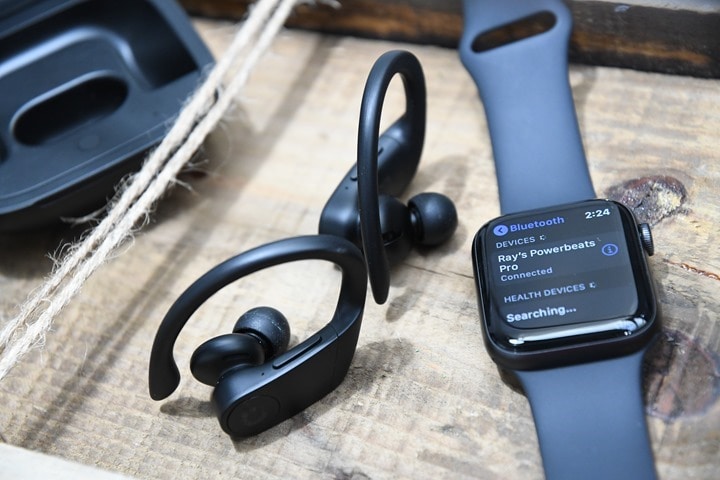
The Apple Watch Series 5 is a great all-around smartwatch. In fact, it’s probably one of the best smartwatches. But I’m actually not convinced it’s the best smartwatch Apple’s ever made (or anyone else for that matter). In fact, I actually think the Apple Watch Series 4 might take that crown. While the always-on display of the Series 5 is nice, it’s come at a solid hit to battery life compared to the Series 4. While the official specs often didn’t convey it well, the Series 4 actually easily got 2 full days, sometimes even into the 3rd day. The Series 5 simply can’t last 24 hours, and that’s before we apply a workout to it. It’s official spec is 18hrs, and even delivering on that can be tough depending on the day.
Yes, the Apple Watch series (irrespective of model) is a fantastic non-fitness watch. Easily the best out there, if you’re on iOS already. The integration within Apple’s ecosystem is incredibly well executed, and all the little bits mostly work. I say mostly, because as anyone will have pointed out, the blend of iOS13 and WatchOS6 has been rough these first two months, however, things have started to stabilize. It’s been at least a few weeks since the watch did funky things like randomly restart or lose notifications for half the day without reason. It’s acting like it should now.
And if I ignore the battery hit, the always-on display of the Series 5 is by far the best executed, namely in terms of nighttime viewing. Albeit not 3rd party apps. The barely visible but still functional nighttime glow of the screen nails it, compared to competitors that still end up having a bright spotlight of an always-on display under the sheets in bed. I just wish Apple would have launched it with 3rd party support. I’m sure in time it’ll come.
So in summary, for sports and fitness – the Series 5 is mostly as good as the previous units. Which means for many people it’s all they’ll need to get/stay in shape, train for a race, or even compete in that running race. You can do all those things with the Apple Watch just fine. But, other sports/fitness wearables will cater to those things better, more natively. And if you’re looking to go hiking or climbing in extreme weather – this really isn’t the watch for that. But it’s a fantastic watch for day to day life.
With that – thanks for reading!
Found this review useful? Support the site! Read on!
Hopefully you found this review useful. At the end of the day, I’m an athlete just like you looking for the most detail possible on a new purchase – so my review is written from the standpoint of how I used the device. The reviews generally take a lot of hours to put together, so it’s a fair bit of work (and labor of love). As you probably noticed by looking below, I also take time to answer all the questions posted in the comments – and there’s quite a bit of detail in there as well.
If you’re a fan of Amazon, you can pick up Apple Watch Series 5 that way and it helps support the site! It doesn’t cost you anything extra, yet helps here a bunch. If you’re outside the US, it should automatically find the right Amazon country for you – but you can always use the big Amazon country links on the right sidebar if so! Oh, and in the future if you just click that Amazon logo before buying anything else (like laundry detergent or toilet paper), that supports the site too!
And of course – you can always sign-up to be a DCR Supporter! That gets you an ad-free DCR, and also makes you awesome. And being awesome is what it’s all about!
Thanks for reading! And as always, feel free to post comments or questions in the comments section below, I’ll be happy to try and answer them as quickly as possible. And lastly, if you felt this review was useful – I always appreciate feedback in the comments below. Thanks!

